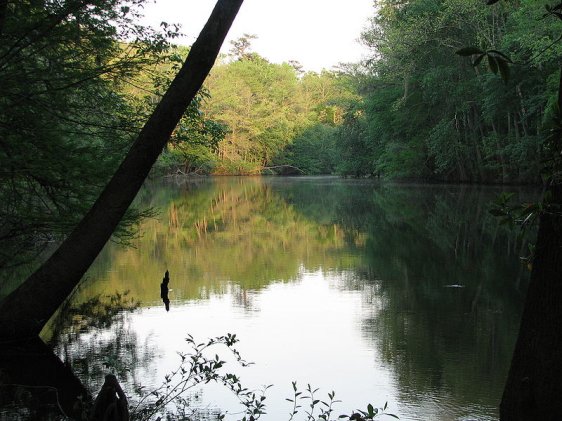Congaree National Park is a national park in the state of South Carolina. Established on 10 November, 2003, it covers 21,867 acres (88.49 sq km) in Richland County near Columbia. 70% of the national park is also designated a wilderness area. The influential Sierra Club was instrumental in speadheading a campaign to preserve the old growth forest at Congaree, an effort initiated as far back as 1969.
Congaree National Park is the largest tract of old growth floodplain forest in North America. Fed by the Congaree River, it is an important part of the Middle Atlantic coastal forests ecoregion. Congaree is the best place to view a floodplain forest with its towering champion trees, some of the tallest trees in eastern United States.
 Weston Lake, Congaree National Park, South Carolina
Weston Lake, Congaree National Park, South Carolina http://commons.wikimedia.org/wiki/File:Cong_weston_lake.JPG
http://commons.wikimedia.org/wiki/File:Cong_weston_lake.JPG Theresa Thom, National Park Service Photo
Theresa Thom, National Park Service Photo
Visitors to Congaree National Park can enjoy hiking, canoeing, kayaking and bird watching. There is also a broadwalk loop that allows visitors to explore the swampy environment in comfort. The elevated walkway is 2.4 miles long.
Congaree National Park has a rich variety of wildlife. It is home to amphibians, turtles, snakes and alligators, as well as a good many types of fish. The wildlife also include bobcats, deer, feral pigs and coyotes.
Visiting Congaree National Park, South Carolina
Congaree National Park is 20 miles to the southeast of Columbia, South Carolina. The nearest interstate highway is I-77. Get off it at Exit 5 and head southeast on Bluff Road (aka South Carolina State Highway 48). Follow the brown Congaree National Park signboard.While the national park is open at all times every day of the year, the visitor center is open from 8:30 am to 5:00 pm, every day except Christmas Day. During Daylight Savings Time, it is open until 7:00 pm on Fridays, Saturdays and Sundays. There is no entrance fee to visit Congaree National Park.
List of National Parks in the United States
 Latest updates on Penang Travel Tips
Latest updates on Penang Travel Tips

Copyright © 2003-2025 Timothy Tye. All Rights Reserved.

 Go Back
Go Back